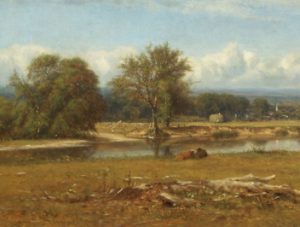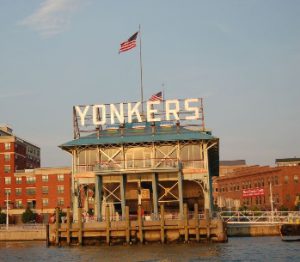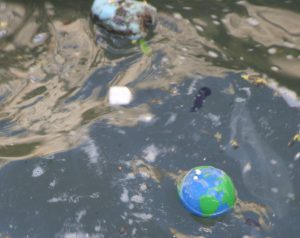The Hudson River History
 The Hudson River, breathtakingly beautiful, the source of pleasure and life for a multitude of microscopic organisms, insects, fish, birds and people. At the same time it suffers from neglect and abuse. What exactly is the Hudson? What fish live there and are they safe to eat? Where does the pollution in the river come from? Read on to learn the answers to these common questions and more!
The Hudson River, breathtakingly beautiful, the source of pleasure and life for a multitude of microscopic organisms, insects, fish, birds and people. At the same time it suffers from neglect and abuse. What exactly is the Hudson? What fish live there and are they safe to eat? Where does the pollution in the river come from? Read on to learn the answers to these common questions and more!
Across the River…The Palisades
The Palisades-cliffs of rock in beautiful and unusual geologic formation border the river for miles, from Mt. Ivy in Rockland County south to Staten Island. They can be seen looking out across the river from Yonkers.
The Palisades were formed when molten magma (melted rock) within the earth extruded upward through the softer sandstone rock and cooled before reaching the surface. Water erosion removed the soft stone around the hardened magma, and left the towering cliffs of vertical rock columns that we see today. If you see light sections of rock, it is an indication of recent rock fall.
The Native Lenni Lenape Indians called the Palisades “We-awk-en”-meaning rocks that look like rows of trees.
The highest point of the Palisades is at High Tor- 837 ft., at the northern end of the Palisades.
There are numerous hiking trails throughout the Palisade region, for more information see The Wild Palisade of the Hudson, by John Serrao.
The rocks of the Palisades are PreCambrian in age, dating to more than 1,100 million years ago.
Some sections of the Palisades are 1,000 feet thick, most of the rock is hidden underneath the vegetation covering the Palisades. We only see a tiny section of these amazing rock formations.
The Palisades were once much higher than they are today- because of erosion they are about half the height they once stood- probably 1000 feet.
In Yonkers…
The Hudson is about 3000 ft. wide- or nearly 6 tenths of a mile.
At low tide the depth of the river in the middle channel is 40 to 45 ft. and at high tide it is 45 to 50 ft. deep.
Common water birds to this area are cormorants, gulls, mallards, and Canada geese.
Birds use the Hudson River as a migrating route from northern breeding grounds to southern wintering areas. This route is called the Atlantic Flyway. The Hudson estuary is essential in providing food and shelter to the birds in their journey.
Heritage and History of Yonkers
 The area that we know as “Yonkers” was once the Native American Village of Nappeckamack, the “town of swift water”.
The area that we know as “Yonkers” was once the Native American Village of Nappeckamack, the “town of swift water”.
The Native Americans were of Algonquin lineage, Mohegan tribe and either the Weckquaskeck or Reckgawance chieftancy.
Wildcats, wolves, bears, beavers, otters, minks, deer and buffalo, as well as many other animals, were once abundant in this area. Due to development and exploitive hunting and trapping after European settlement, these animals are now scarce, or gone altogether, from this region.
In 1638 the Dutch West India Company bought the land of present day Yonkers from the Native Americans.
Yonkers was incorporated as a town on March 7, 1788, in 1855 part of the town was incorporated as a village and in 1872, Yonkers was incorporated as a city. Currently it is the fourth largest city in New York State.
Areas adjacent to rivers often become developed and industrialized to make use of easy trade and shipping access- it is a direct result of the Hudson River that Yonkers developed and flourished.
Yonkers has been a trading and shipping post since early times when it was an agricultural area known as the “pickle port”. A hat factory was established in 1840, an elevator plant in 1854, and soon after, a sugar refinery.
Fish
About 200 fish have been documented to live in the Hudson estuary for some or all portions of their lives throughout the year millions of fish, both marine and freshwater species, utilize the lower Hudson as a spawning, nursery and feeding ground.
Fish common to the river off Yonkers are striped bass, white perch, bluefish, eel, herring, largemouth bass, carp, needlefish, tomcod, sunfish, sturgeon, blue crab and shad. Many of these fish were important to the commercial fishing industry, and are crucial to the balance of life in the river.
Due to PCB and heavy metal contamination, there are restrictions concerning fish from the Hudson that can be consumed safely. According to the U.S. Department of Health, striped bass, American eel and shellfish, among others, ahould not be eaten at all. They advise no more than 1 serving of bluefish, northern pike and other specified species in one month’s time, and no more than 6 blue crabs per week.
Long term exposure to the chemicals these fish have accumulated in their tissues can cause adverse health affects in humans – possibly cancer and nervous system disorders.
The Bad, The Smelly and The Dangerous…Pollution
 Although beautiful and rich, supporting a diversity of life, the Hudson River has serious pollution problems.
Although beautiful and rich, supporting a diversity of life, the Hudson River has serious pollution problems.
Oil spills, industrial discharges, leaking landfills, widespread pesticide use, sewage treatment plant discharge, PCB contamination and individual actions such as unneccesary use of water, pouring used motor oil and hazardous household chemicals down the drain, littering. All of this damage and threaten the quality of life in the Hudson.
The Hudson can handle a certain amount of pollution naturally- it has a limestone rock base that contains calcium carbonate, effective in neutralizing acid and the effects of acid rain. The marshes in the river serve as natural filters that clean water as it passes through.
However, there has been such an onslaught of pollution and abuse to the river that even its incredible natural ways of handling pollution are not enough. Many of the marshes have been filled in to create more space for development.
The past 20 years has brought greater protection of the river through legislation, such as the Clean Water Act of 1972, which imposes restrictions on industries dumping their waste in waterways. Now, industries are required to have permits- the amount of waste dumped in the Hudson has decreased and the quality of the river is improving.
THE RIVER NEEDS YOUR HELP! The Hudson is getting cleaner, with your help and conscious actions it will continue to rejuvenate and flourish.
Tributaries
A tributary is any stream, brook or river that feeds into a main, large river.
There are 6,077 total stream miles that tributary to the 155 tidal miles of the Hudson.
Tributaries have a direct effect on the river, they transport nutrients, pollutants, organisms, dissolved minerals, and organic and inorganic suspended sediment to the Hudson estuary.
The tributaries of the lower Hudson basin contribute about 14% of total river flow.
The Saw Mill River, a tributary to the Hudson, flows nearly 23 miles from the Town of New Castle to where it enters the river at Dock Street in Yonkers.
The Saw Mill actually flows underneath Yonkers, in a tunnel called the flume, for 2,000 feet – 4 tenths of a mile.
All the rain that eventually feeds into a river, through tributaries, ground water, etc. comes from an area of land called a watershed.
The Saw Mill River watershed is 26.5 square miles.
The watershed to the Hudson is 13,344 square miles, or about 28% of New York State.
Sewage Treatment
The sewage treatment plant, located off Ludlow Street in Yonkers serves half a million people in Westchester County, from as far north as Peekskill, south to the Bronx, including Ossining, Mount Kisco, Yonkers, New Rochelle and many other communities.
The plant is designed to treat 92 million gallons per day (mgd) of wastewater.
During heavy rains, the plant cannot handle the overflow- as much as 80 mgd of raw sewage is discharged either through unofficial outfall pipes or from the plant itself with little or no treatment.
This CSO-combined sewage overflow- is detrimental and polluting to life in the Hudson.
After rains, health officials advise against swimming in the Hudson off Yonkers, because of high bacterial counts in the water.
This Is Your River!
With concern and conscious action the Hudson River can be protected and preserved for future generations to enjoy – do your part in the conservation of this unique and beautiful ecosystem.
